“Sister Corita Kent expanded the cultural terrain with her rebellious art-activism”.
“She saw her calling to use art as a response to cultural discord… driven by her passions for world peace, civil rights, spirituality, dissent and anti-war activism”.
“In recent years she has gained overdue recognition for her role in the Pop Art Movement . . . but to the world then, she did not look like the stereotype of the artist of her time: Corita was a woman and she wore a habit”.

Bell Brand, 1967, Silkscreen Print on Pellon
The Summer of Women:
In the Beginning was the Word: Works by Corita Kent (May 14 – Sept. 18)
Suddenly Last Summer: Site-Specific Installations by Leah Brown, Donna Haynes and Michelle Weinberg (May 14 – Sept. 25)
Resonance/Dissonance: Group Exhibition featuring Women Video Artists from the de la Cruz Collection (June 18 – Sept. 25)
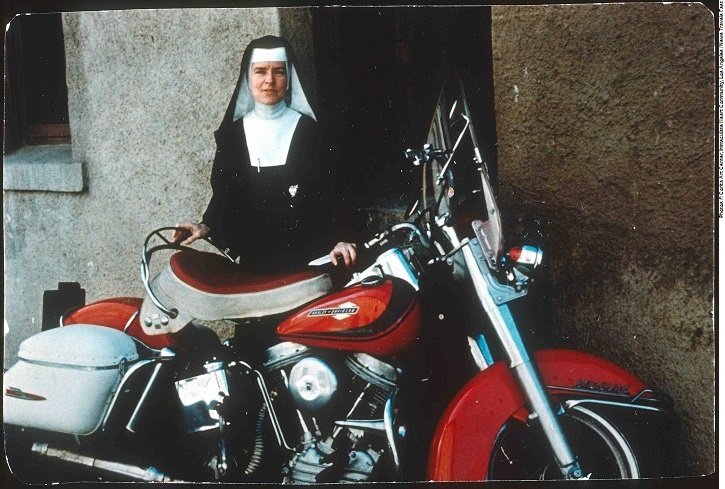
MIAMI [ ABN NEWS ] — The Summer of Women begins on May 14 at the Patricia & Phillip Frost Art Museum FIU, and runs through September debuting three original exhibitions featuring women artists. First-off is a fresh look at the artwork of rebel-nun/Pop Art pioneer Corita Kent.
The exhibition, titled In the Beginning was the Word: Works by Corita Kent, ushers in The Summer of Women with an opening reception on Saturday, May 14 (4–7 p.m.), on view through September 18. This new exhibition (originating at the Frost Art Museum FIU) presents a collection of fifty works bursting with color and meaningful text, selected to showcase the artist’s Pop Art legacy and memorable calls-to-action for social justice.
In the beginning was the Word celebrates Corita’s fusing of iconic quotes from popular culture with spiritual texts and American consumerism brand iconography from the 1960s and 1970s (including street signs, product packaging, ad slogans, song lyrics and billboards).
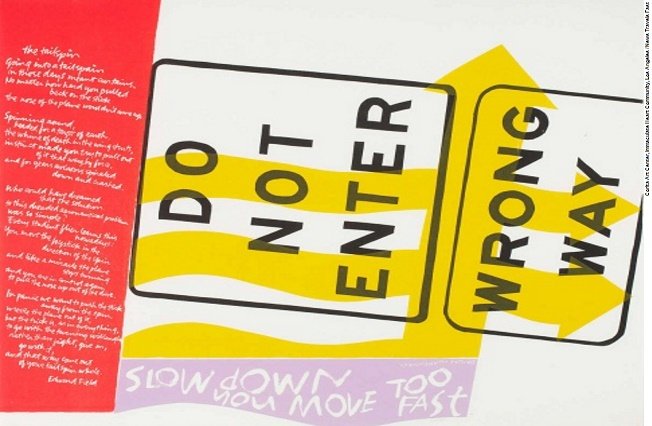
Feelin’ Groovy, 1967, Silkscreen Print on Pellon
Corita Kent – also known in the 1960s as Sister Mary Corita – embedded her art with messages driven by her passions for world peace, civil rights, spirituality, dissent and anti-war activism.
She helped spearhead the establishment of silkscreen (serigraphy) as a fine art medium and expanded the cultural terrain with her artful “happenings” and rebellious art-activism.
Corita is also recognized historically as a pioneer in art education, a feminist, and an influential designer (the American Institute of Graphic Arts lauded her as a 2016 Medalist). In recent years she has gained overdue recognition for her role in the Pop Art Movement.
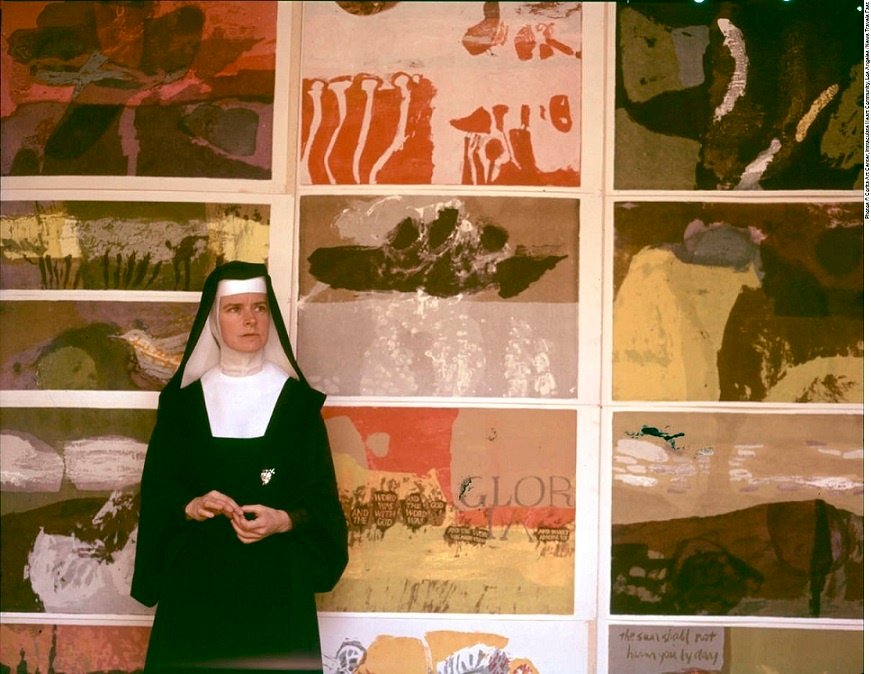
“The Patricia & Phillip Frost Art Museum FIU launches The Summer of Women with Corita Kent’s powerful, graphic art,” says the Frost Art Museum’s Director, Dr. Jordana Pomeroy.
“Recently the world has begun to grant Corita Kent the recognition she deserves, including the first full-scale survey of her work last year at the Andy Warhol Museum, prominent exhibitions at the National Museum of Women in the Arts and the Harvard Art Museums, and an upcoming exhibition at the Victoria and Albert Museum in London.”
“Her works reflect the activist ethos of the time and express her concerns about racism, poverty, and the Vietnam War. As a professor of art at the Immaculate Heart College in Los Angeles – and a modern nun – she saw her calling to use art as a response to cultural discord and shifts in public sentiment. Corita Kent’s legacy as a Sister who sought to awaken social consciousness in the United States is exemplified by her dynamic colorful prints that continue to provoke discussion and promulgate sentiments about social iniquities that still exist in our society, half a century after their creation,” adds Dr. Pomeroy.
To the world, she did not look like the stereotype of the modern artist of her time: Corita was a woman and she wore a habit.
She was a Sister of the Immaculate Heart of Mary from 1936-1968. Corita received her Master’s degree in Art History from the University of Southern California in 1951, and by 1964 she was named Chair of the famed Art Department at Immaculate Heart College.
She taught her students about art that was prevalent and visible in Los Angeles at that time – especially Pop Art. Her lectures referenced Robert Indiana, Claes Oldenburg and Ed Ruscha, artists who may have inspired her art-making.
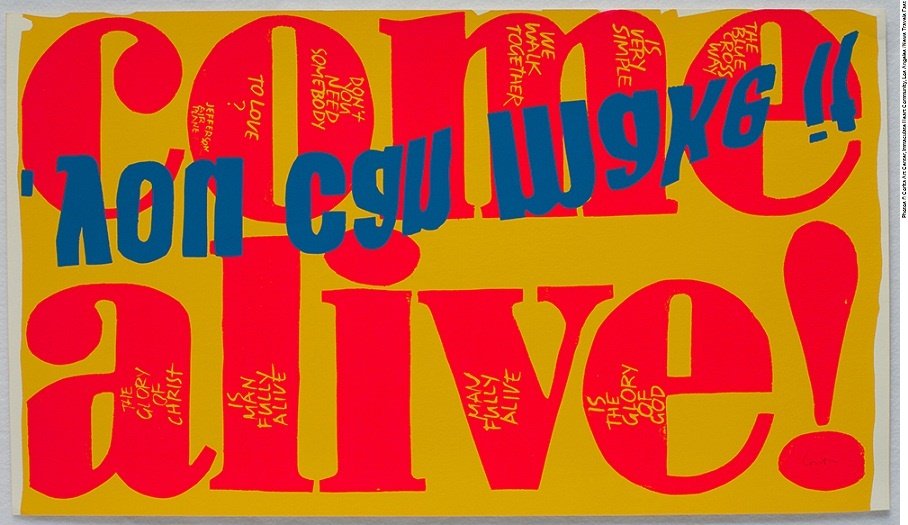
Come Alive, 1967, Silkscreen Print on Paper
Corita adapted mainstream advertisements into her work and transformed them into messages of love, human dignity, grace and social justice.
She elevated silkscreen printing to fine art and through her work was able to communicate the spiritual resonance of ordinary objects such as traffic signs warning “WRONG WAY” and “DO NOT ENTER,” popular magazine and television advertisements for soda, tomato sauce and potato chips, and song lyrics from Top 40 hits.
Examples of how Kent re-appropriated imagery include representing angels as airplanes and Wonderbread as the Eucharist. She revealed spirituality in common experiences shared by all, and imbued her colorful designs with joyful exclamations.

Sister Corita Kent
Corita championed tirelessly against the Vietnam War through her art, and her cries for peace were not always welcome.
She was moved to action by the changes brought forth by the Second Vatican Council of the Roman Catholic Church (the artist was featured on the cover of Newsweek Magazine in 1967 with the headline “The Nun: Going Modern”) and she challenged her superiors at her local Archdiocese.
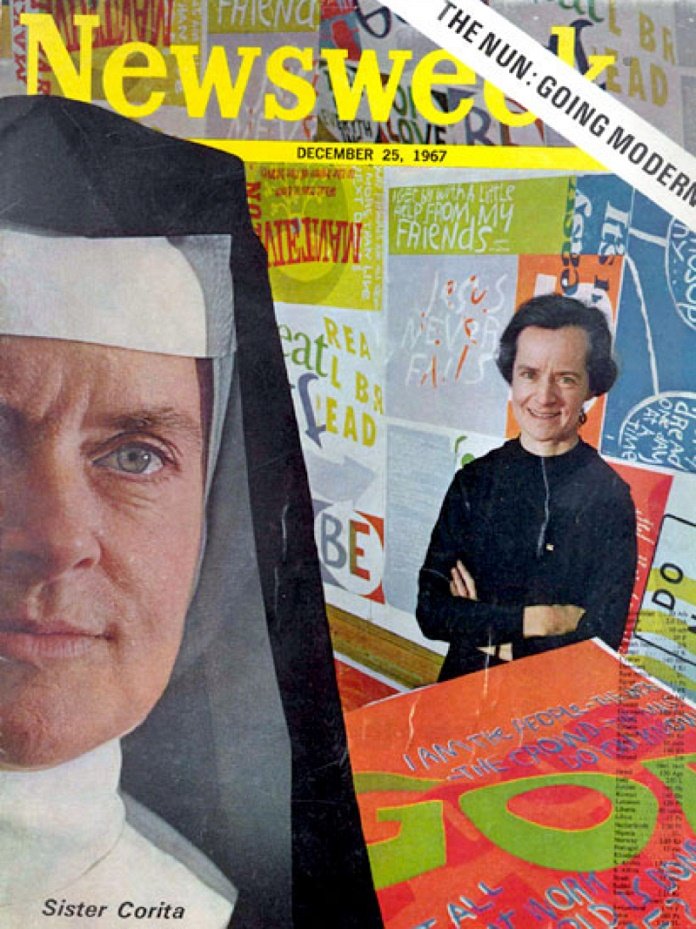
Her chronic insomnia helped spur Corita to lead her art students into round-the-clock, frenzied printing of serigraph designs by the hundreds, often followed by periods of bleak depression for the artist.
After mounting pressures from her Cardinal, she left Los Angeles and the Order in 1968 and moved to Boston where she decided to devote her life entirely to making art.
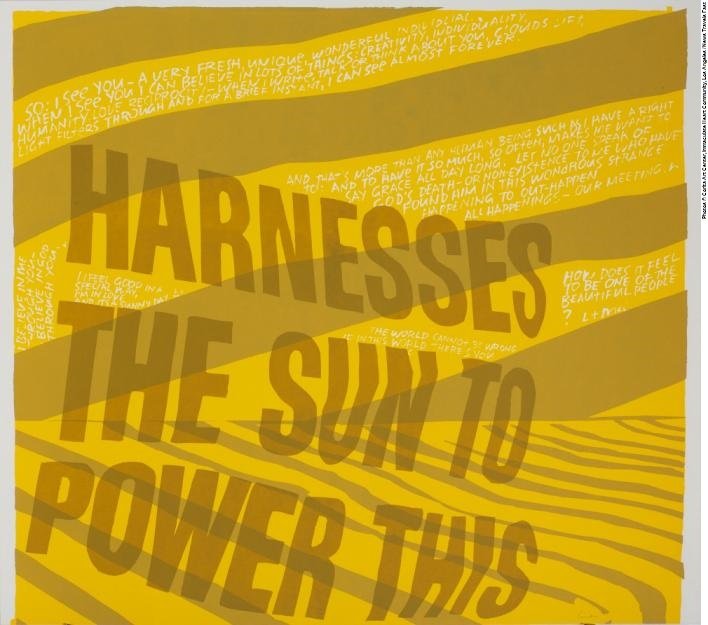
Harness The Sun, Silkscreen Print on Paper
Corita held onto her social and artistic convictions, and words themselves were the subject matter of her prints.
She considered the alphabetical characters used in her texts to be works of art. Sources of her text include the poems of Walt Whitman, the Bible, and speeches by Dr. Martin Luther King Jr. and John F. Kennedy, over which Kent would layer with vibrant splashes of color, corporate logos, slogans and other bits of popular culture.
Corita deconstructed and arranged her compositions to form bright colorations, eye-catching Pop prints that at first glance belie the weightiness of the missives – but later inspire contemplation.
Her most prolific period occurred during the 1970s and 1980s, when she also struggled with cancer several times. This time-period included Corita’s famous 150-foot high “Rainbow Swash” (the world’s largest copyrighted work of art, considered one of Boston’s major landmarks), controversial because many believed the artist embedded a profile of Vietnamese leader Ho Chi Minh to protest the Vietnam War.
Corita’s famous “Love” postage stamp was commissioned in 1985 by the United Postal Service and more than 700 million stamps were sold.
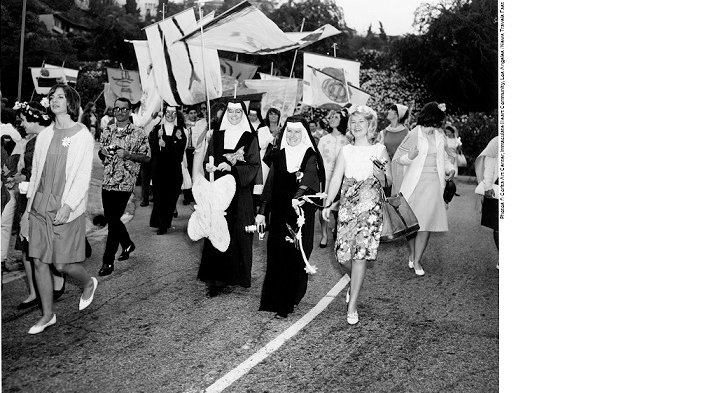
She never strayed from her dedication to social activism, creating posters and billboards for charitable organizations such as Physicians for Social Responsibility, The International Walk for Hunger and Amnesty International. Corita died in 1986 from cancer.
Corita willed her unsold prints, paintings and copyrights of her work to the Immaculate Heart Community, which created the Corita Art Center that today maintains the world’s largest collection of Corita’s work. Facilitating exhibitions of Corita’s art all over the world, the Corita Art Center is dedicated to the preservation and promotion of Corita’s art, her teaching, and her spirit of love, peace and social justice.
“We’re thrilled that Corita’s work is being shared with audiences around the world and this is the first show in Miami in a long time,” says Ray Smith, Director of the Corita Art Center. “We hope viewers will be encouraged by the messages of peace and love that are contained in Corita’s work and stimulated by the bold color choices and innovative designs of her art.”
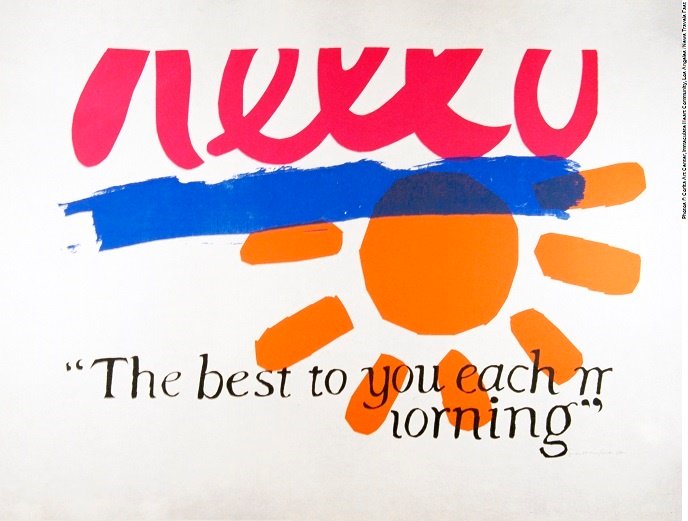
The Best to You Each Morning, 1964, Silkscreen Print on Pellon
Although part of the Pop Art canon, Corita’s work was excluded from male-dominated Pop Art surveys during its heyday and subsequent years. Her recognition paled dramatically to her male contemporaries (including Warhol and Ruscha), and until recently, her work had been overlooked. In 2013, the Warhol Foundation presented the first full- scale survey of her work covering over 30 years of her artistic career.

Help or Something, Silkscreen Print on Paper
The upcoming group exhibition at the Victoria and Albert Museum in London features Corita Kent’s artwork and is titled “You Say You Want a Revolution? Records & Rebels 1966-1970: How have the finished and unfinished revolutions of the late 1960s changed the way we live today and think about the future?”
Corita Kent’s work can be found in several art museums and private collections including the Whitney, the Museum of Fine Arts in Boston and New York’s Metropolitan Museum.
More About The Summer of Women at the Frost Art Museum FIU
The Summer of Women includes two other exhibitions: Suddenly Last Summer also opens May 14 and features new works by South Florida-based artists Leah Brown, Donna Hayes and Michelle Weinberg, curated by AdrienneRose Gionta. Each artist has been given a room to create site-specific installations inspired by the hit song by The Motels.
On June 18, the museum debuts Resonance/Dissonance, curated by Klaudio Rodriguez and featuring the works of women video artists from the de la Cruz Collection including Susanne Wintering, Sarah Morris, Tracey Emin, Aida Ruilova, Dara Friedman and Beatriz Monteavaro.
The Patricia & Phillip Frost Art Museum FIU, the Smithsonian Affiliate in Miami, opened its current 46,000-square-foot, state-of-the-art building in November 2008. Admission to the Museum is always free. The Frost is an American Alliance of Museums accredited museum, and is located on the FIU campus at 10975 SW 17th Street, across from the Blue Garage and adjacent to the Wertheim Performing Arts Center. Hours of operation are Tuesday through Saturday 10 a.m. – 5 p.m. and Sunday noon – 5 p.m. Closed on Mondays and most legal holidays. For more information, please call 305-348-2890 or visit thefrost.fiu.edu.

You must be logged in to post a comment.